Agent-Based Model for Automaticity Management of Traffic Flows across the Network
Abstract
:1. Introduction
2. Autonomic Networking Management
- Level 1: Refers to the continuous monitoring of the elements of the system by means of software tools handled by people who provide manual support in the event of a failure.
- Level 2: Consists of a set of monitoring applications that intelligently collect information to reduce the workload of the network administrator, and is known as the management level.
- Level 3: This level can recognize certain behavior patterns of the network in addition to suggesting actions to be taken by the support staff; this level is also called predictive.
- Level 4: Uses level 3 tools but attempts to minimize human intervention by helping with Service Level Agreements (SLAs); this level is known as adaptive.
- Level 5: Business policies and objectives dynamically manage the system at this level. Its disadvantage is that the automaticity is very closed only based on certain rules, and this level is recognized as autonomous.
3. Measures of Centrality in Networks
4. Architecture of the Agent-Based Model
4.1. Multi-Agent Architecture for Management of Network Flows
- Network: In this level, all nodes are set up with the type of flows that will transmit and their destination. In addition, the agents of each node are initializing with its hierarchy obtained by Equation (1), and these preferences are assigned by the network administrator depending on their policies, and their utilities are set to zero. The agents collect information related to congestion status by sensing the current state of the nodes. When a congestion is recognized by exceeding a threshold, an ECG flag changed their value to one, and this will trigger the activation of the negotiation level.
- Control: Here, the agents detect and classify the flows that arrive at each node. After this, the agents provide the data to the Negotiation level, which holds the decision-making module.
- Negotiation: The algorithm SEHA (Social Election with Hidden Authorities) is triggered in this level when a congestion situation emerges. As a result, a set of actions to be performed by the lower-level agents is selected, achieving with this the optimization of the network status.
4.2. SEHA Social Election with Hidden Authorities Algorithm
| Algorithm 1 SEHA Social Election with Hidden Authorities Algorithm |
| function Findwinner( , , h) set [ with max ] of set modes of if choices length > 1 set prefered_choice [ with max ] of with max h else set return end function |
5. Simulated Scenarios and Results
5.1. Analysis of Results
5.2. Simulation Using the Topology with Scale Free Distribution
5.3. Simulation Using Topology with Degree Distribution
5.4. Comparison of Results
6. Future Work
7. Conclusions
Acknowledgments
Author Contributions
Conflicts of Interest
Appendix A
| Cost | Link | |
|---|---|---|
| End1 | End2 | |
| 0.442 | node 1 | node 0 |
| 0.759 | node 1 | node 3 |
| 0.788 | node 1 | node 6 |
| 0.778 | node 1 | node 7 |
| 0.848 | node 1 | node 16 |
| 0.668 | node 2 | node 1 |
| 0.293 | node 4 | node 3 |
| 0.609 | node 5 | node 2 |
| 0.577 | node 5 | node 13 |
| 0.165 | node 7 | node 10 |
| 0.217 | node 8 | node 2 |
| 0.392 | node 8 | node 17 |
| 0.517 | node 8 | node 19 |
| 0.045 | node 9 | node 3 |
| 0.850 | node 9 | node 14 |
| 0.790 | node 11 | node 3 |
| 0.924 | node 12 | node 7 |
| 0.053 | node 15 | node 2 |
| 0.322 | node 17 | node 22 |
| 0.089 | node 18 | node 1 |
| 0.678 | node 20 | node 15 |
| 0.364 | node 21 | node 20 |
| 0.801 | node 23 | node 15 |
| Source Node | Color | Preferences | Num. Flows | Type Flows | Destination Node |
|---|---|---|---|---|---|
| 0 | yellow | 1 2 0 | 1 | 1 | 21 |
| 1 | yellow | 1 2 0 | 4 | 1,0,2,0 | 10,21,7,9 |
| 2 | green | 0 1 2 | 1 | 2 | 14 |
| 3 | pink | 0 2 1 | 2 | 1,1 | 22,6 |
| 4 | green | 0 1 2 | 3 | 1,2,2 | 22,3,21 |
| 5 | green | 0 1 2 | 5 | 1,2,2,0,0 | 8,7,21,15,7 |
| 6 | green | 0 1 2 | 3 | 1,0,0 | 22,10,21 |
| 7 | yellow | 1 2 0 | 1 | 0 | 6 |
| 8 | red | 2 1 0 | 1 | 1 | 20 |
| 9 | pink | 0 2 1 | 1 | 2 | 7 |
| 10 | orange | 1 0 2 | 1 | 1 | 17 |
| 11 | orange | 1 0 2 | 2 | 0,2 | 19,5 |
| 12 | green | 0 1 2 | 2 | 1,0 | 1,2 |
| 13 | gray | 2 0 1 | 2 | 1,0 | 21,8 |
| 14 | orange | 1 0 2 | 3 | 1,2,0 | 23,23,1 |
| 15 | gray | 2 0 1 | 1 | 2 | 20 |
| 16 | pink | 0 2 1 | 1 | 1 | 1 |
| 17 | pink | 0 2 1 | 4 | 1,2,0,1 | 11,20,7,4 |
| 18 | red | 2 1 0 | 2 | 2,1 | 23,20 |
| 19 | orange | 1 0 2 | 2 | 2,2 | 12,10 |
| 20 | gray | 2 0 1 | 2 | 1,0 | 5,19 |
| 21 | gray | 2 0 1 | 2 | 2,2 | 8,19 |
| 22 | yellow | 1 2 0 | 3 | 2,1,2 | 13,8,3 |
| 23 | pink | 0 2 1 | 0 | - | - |
| Ticks/Agent in Node | 1 | 2 | 3 | 4 | 5 | 6 | 7 | 8 |
|---|---|---|---|---|---|---|---|---|
| node 0 | ||||||||
| node 1 | 1 | 1 | 1 | |||||
| node 2 | 1 | |||||||
| node 3 | 1 | 1 | 1 | |||||
| node 4 | 1 | |||||||
| node 5 | ||||||||
| node 6 | 1 | 1 | 1 | |||||
| node 7 | 1 | |||||||
| node 8 | 1 | 1 | 1 | |||||
| node 9 | 1 | 1 | ||||||
| node 10 | 1 | 1 | 1 | 1 | ||||
| node 11 | ||||||||
| node 12 | ||||||||
| node 13 | 1 | |||||||
| node 14 | ||||||||
| node 15 | 1 | 1 | ||||||
| node 16 | ||||||||
| node 17 | 1 | 1 | ||||||
| node 18 | 1 | 1 | 1 | |||||
| node 19 | ||||||||
| node 20 | 1 | 1 | 1 | 1 | ||||
| node 21 | 1 | |||||||
| node 22 | ||||||||
| node 23 | 1 | 1 | 1 |
| Ticks /Agent in Node | 1 | 2 | 3 | 4 | 5 | 6 | 7 | 8 |
|---|---|---|---|---|---|---|---|---|
| node 0 | 1 | |||||||
| node 1 | 1 | 1 | 1 | 1 | ||||
| node 2 | ||||||||
| node 3 | 1 | 1 | 1 | 1 | ||||
| node 4 | 1 | |||||||
| node 5 | ||||||||
| node 6 | 1 | 1 | 1 | |||||
| node 7 | 1 | 1 | 1 | 1 | 1 | 1 | ||
| node 8 | 1 | 1 | 1 | 1 | 1 | 1 | 1 | |
| node 9 | ||||||||
| node 10 | 1 | 1 | 1 | 1 | 1 | |||
| node 11 | ||||||||
| node 12 | 1 | |||||||
| node 13 | 1 | 1 | ||||||
| node 14 | 1 | |||||||
| node 15 | 1 | 1 | 1 | |||||
| node 16 | 1 | 1 | 1 | 1 | ||||
| node 17 | ||||||||
| node 18 | 1 | 1 | ||||||
| node 19 | 1 | 1 | 1 | |||||
| node 20 | 1 | 1 | ||||||
| node 21 | 1 | 1 | ||||||
| node 22 | 1 | |||||||
| node 23 |
References
- Samaan, N.; Karmouch, A. Towards autonomic network management: An analysis of current and future research directions. IEEE Commun. Surv. Tutor. 2009, 11, 22–36. [Google Scholar] [CrossRef]
- Mitchell, M. Complexity: A Guided Tour; Oxford University Press, Inc.: New York, NY, USA, 2009. [Google Scholar]
- Toroczkai, Z. Complex networks the challenge of interaction topology. Los Alamos Sci. 2005, 29, 94–109. [Google Scholar]
- Movahedi, Z.; Ayari, M.; Langar, R.; Pujolle, G. A survey of autonomic network architectures and evaluation criteria. IEEE Commun. Surv. Tutor. 2012, 14, 464–490. [Google Scholar] [CrossRef]
- International Business Machines Corporation. An Architectural Blueprint for Autonomic Computing; IBM Corporaton: Hawthorne, NY, USA, 2005. [Google Scholar]
- Kalton, M.C.; Mobus, G.E. Principles of Systems Science. Understanding Complex Systems; Springer: New York, NY, USA, 2015. [Google Scholar]
- Sayama, H. Introduction to the Modeling and Analysis of Complex Systems; Milne Library: Geneseo, NY, USA, 2015. [Google Scholar]
- Newman, M. Networks: An Introduction; Oxford University Press, Inc.: New York, NY, USA, 2010. [Google Scholar]
- Freeman, L.C. Centrality in social networks conceptual clarification. Soc. Netw. 1978, 1, 215–239. [Google Scholar] [CrossRef]
- Pavlopoulos, G.A.; Secrier, M.; Moschopoulos, C.N.; Soldatos, T.G.; Kossida, S.; Aerts, J.; Schneider, R.; Bagos, P.G. Using graph theory to analyze biological networks. BioData Min. 2011, 4. [Google Scholar] [CrossRef] [PubMed]
- Lada, A.A.; Rajan, M.L.; Huberman, B.A. Local Search in Unstructured Networks. In Handbook of Graphs and Networks; Wiley-VCH: Weinheim, Germany, 2003. [Google Scholar]
- Gladwell, M. The Tipping Point: How Little Things Can Make a Big Difference; Little Brown: Boston, MA, USA, 2000. [Google Scholar]
- Lempert, R. Agent-based modeling as organizational and public policy simulators. Proc. Natl. Acad. Sci. USA 2002, 99 (Suppl. S3), 7195–7196. [Google Scholar] [CrossRef] [PubMed]
- Introduction to Cisco IOS NetFlow—a technical overview. Available online: http://www.cisco.com/en/US/prod/collateral/iosswrel/ps6537/ps6555/ps6601/prod_white_paper0900aecd80406232.html (accessed on 1 September 2017).
- Wooldridge, M. An Introduction to MultiAgent Systems; Wiley Publishing: Hoboken, NJ, USA, 2009. [Google Scholar]
- Barabási, A.L. Linked: How Everything Is Connected to Everything Else and What It Means for Business, Science, and Everyday Life; Basic Books: New York, NY, USA, 2014. [Google Scholar]
- Barabási, A.L. Network Science; Cambridge University Press: Cambridge, UK, 2017. [Google Scholar]
- Weiler, R.; Engelbrecht, J.; Cadmus, J. The New Sciences of Networks & Complexity: A Short Introduction. Cadmus 2013, 2, 131–141. [Google Scholar]
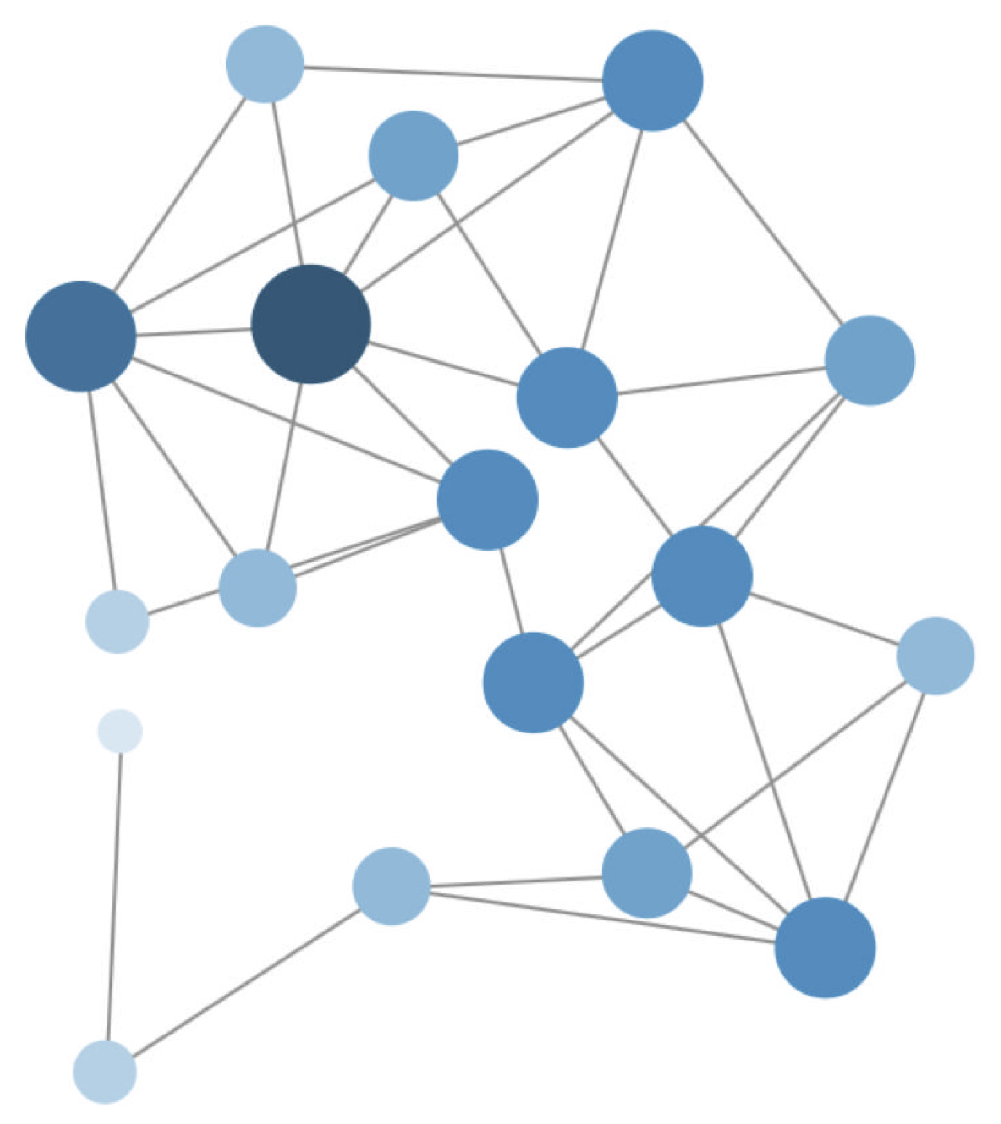

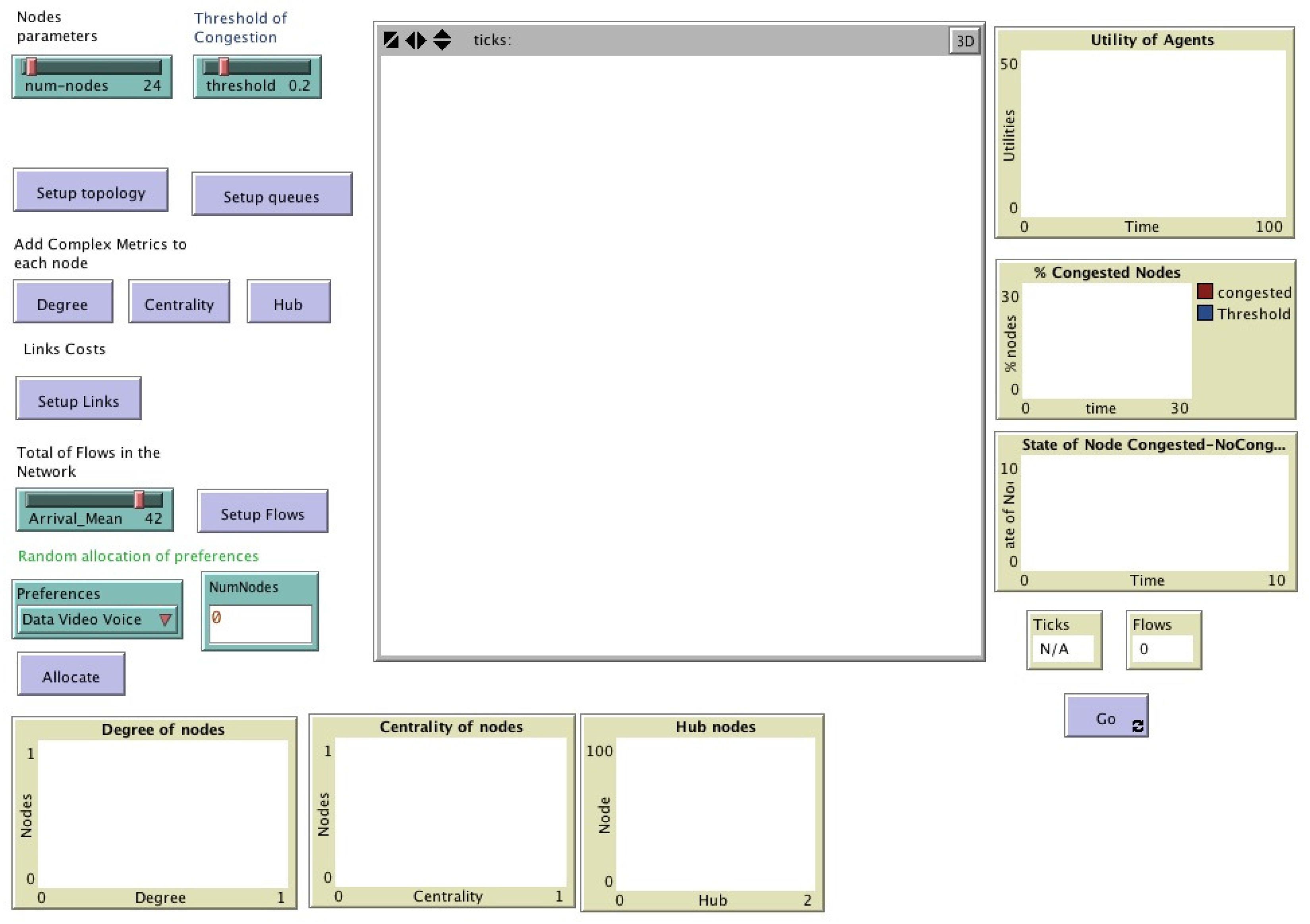

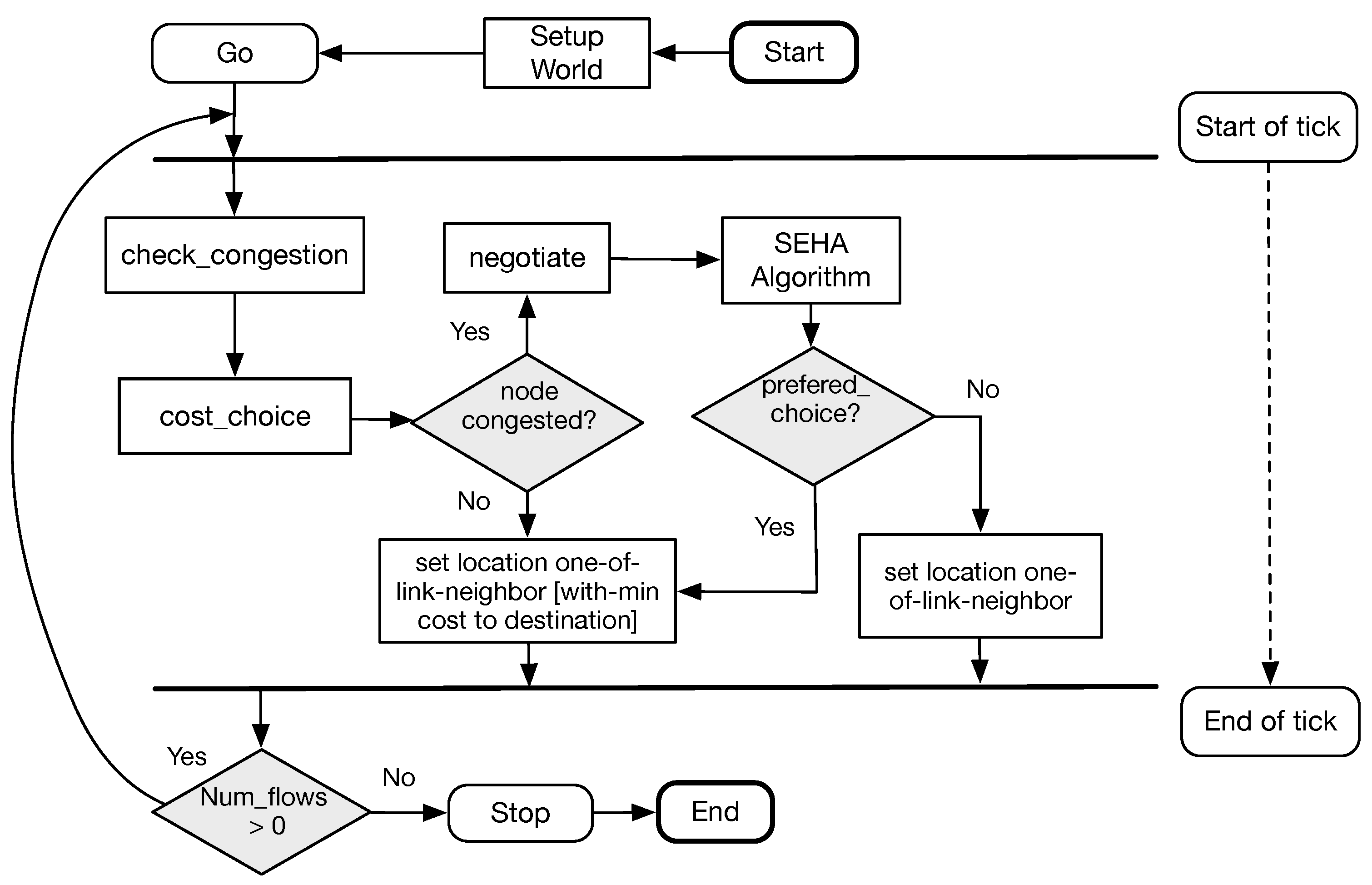


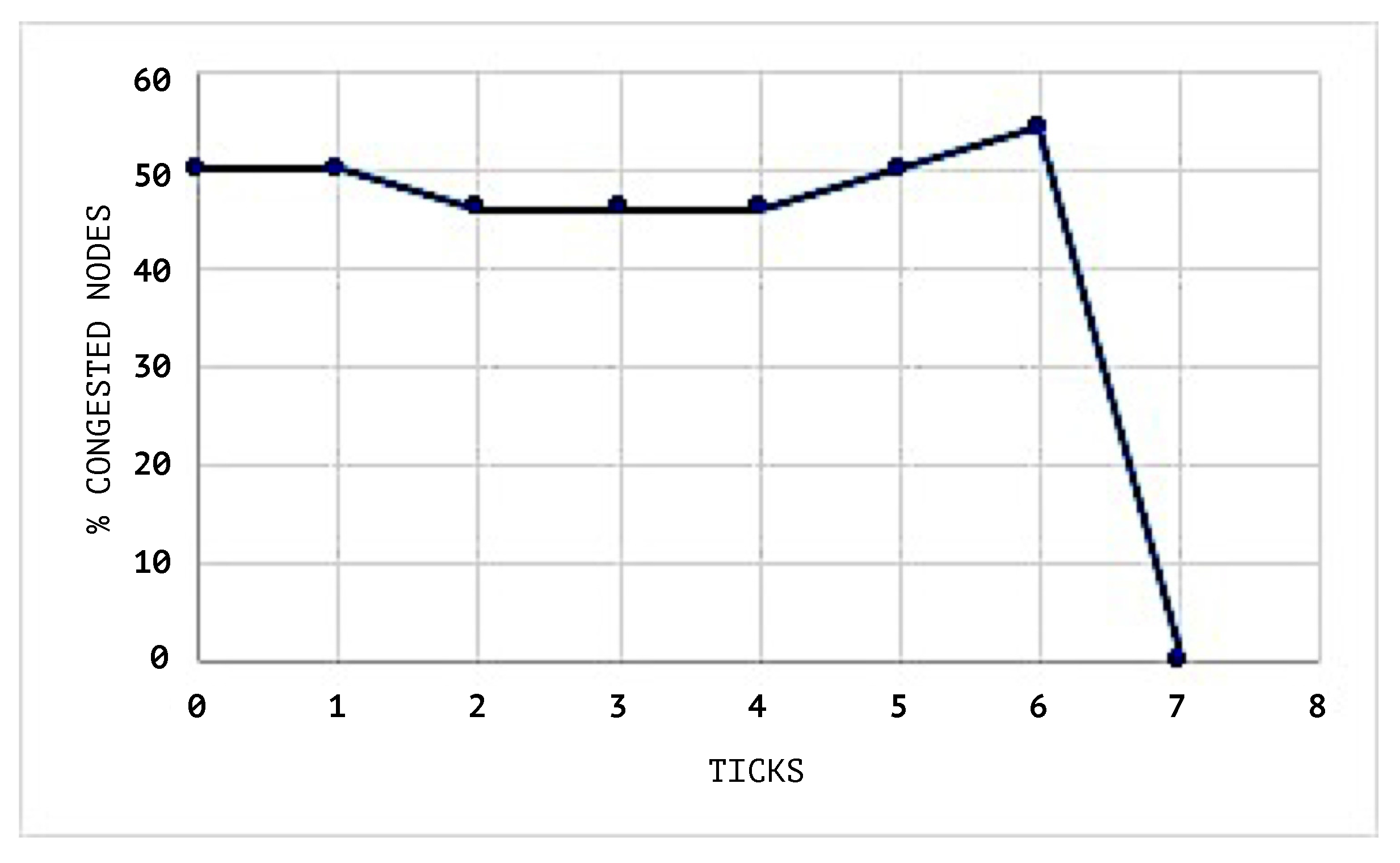
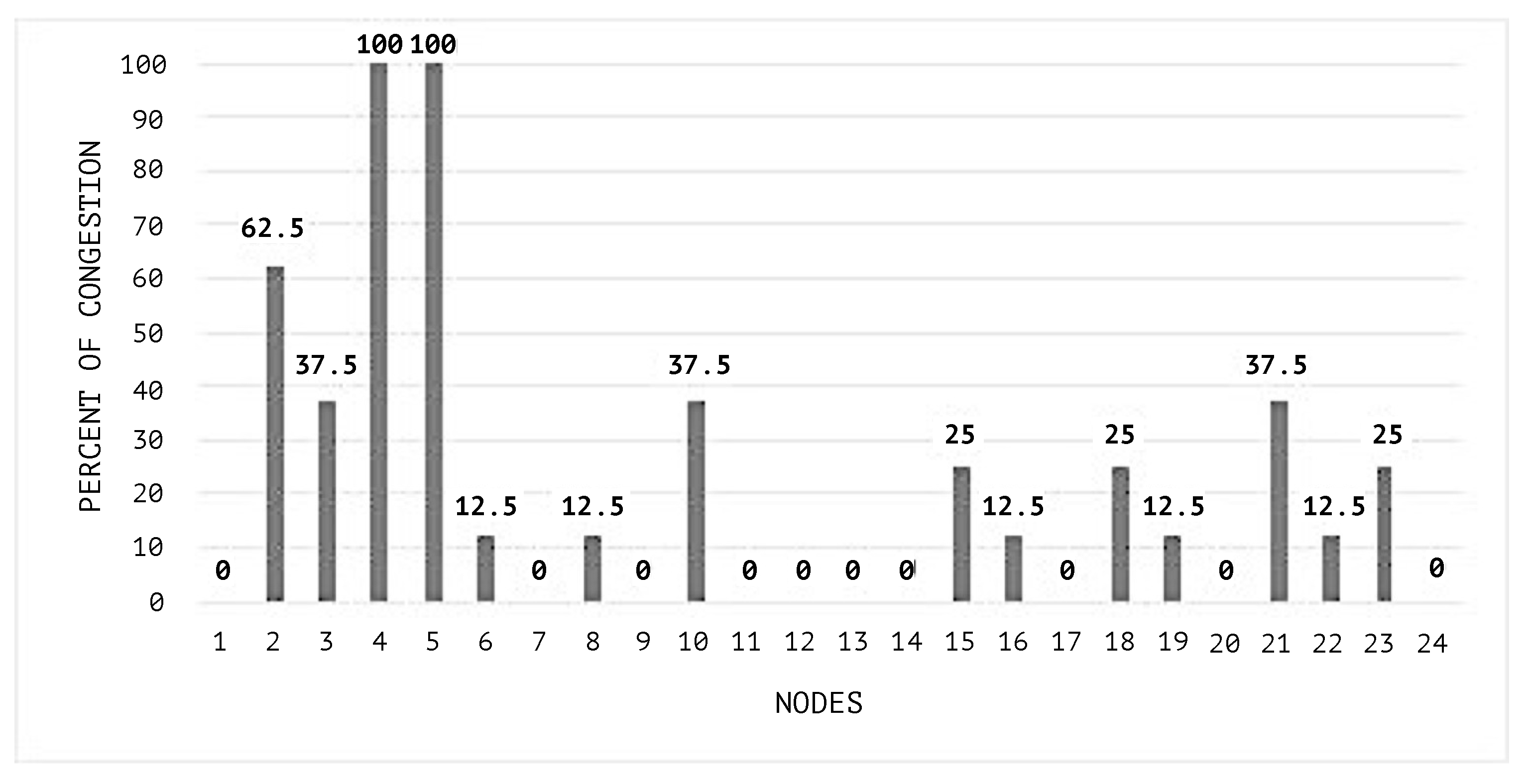

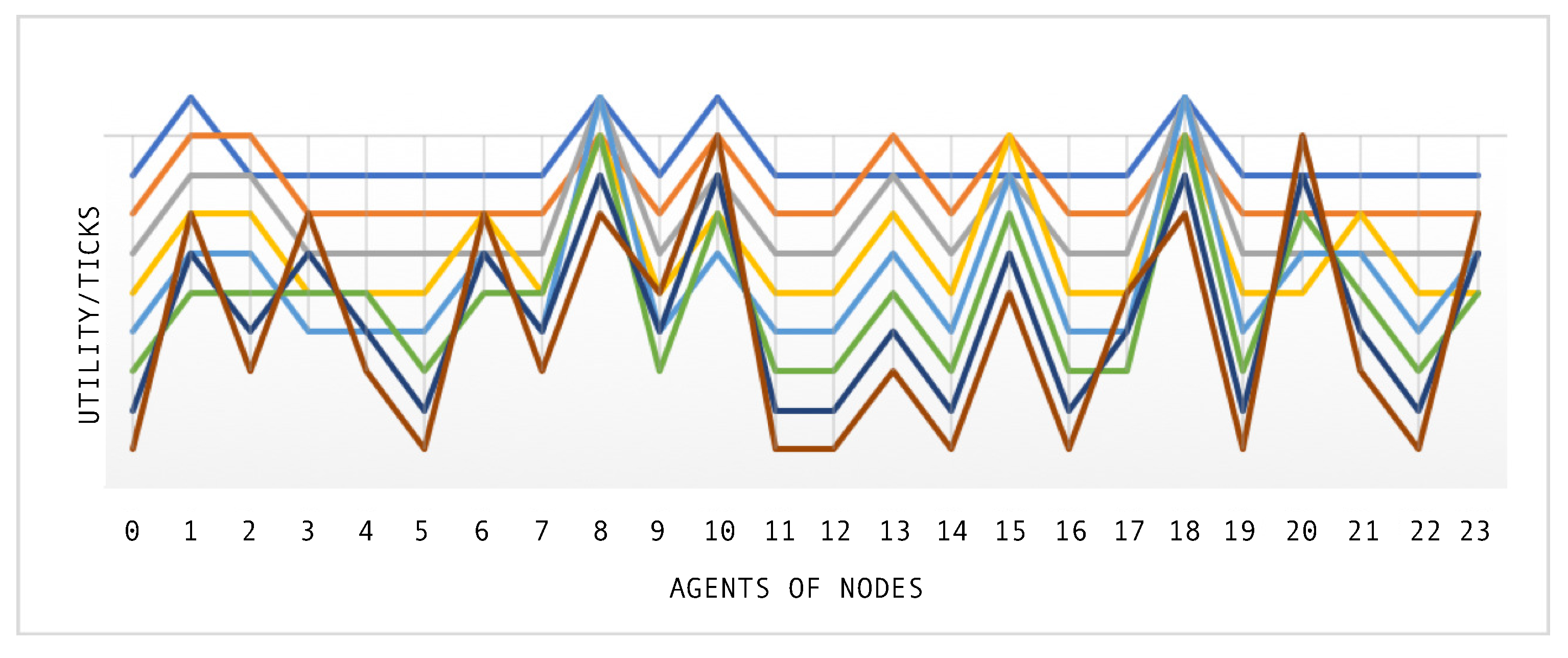


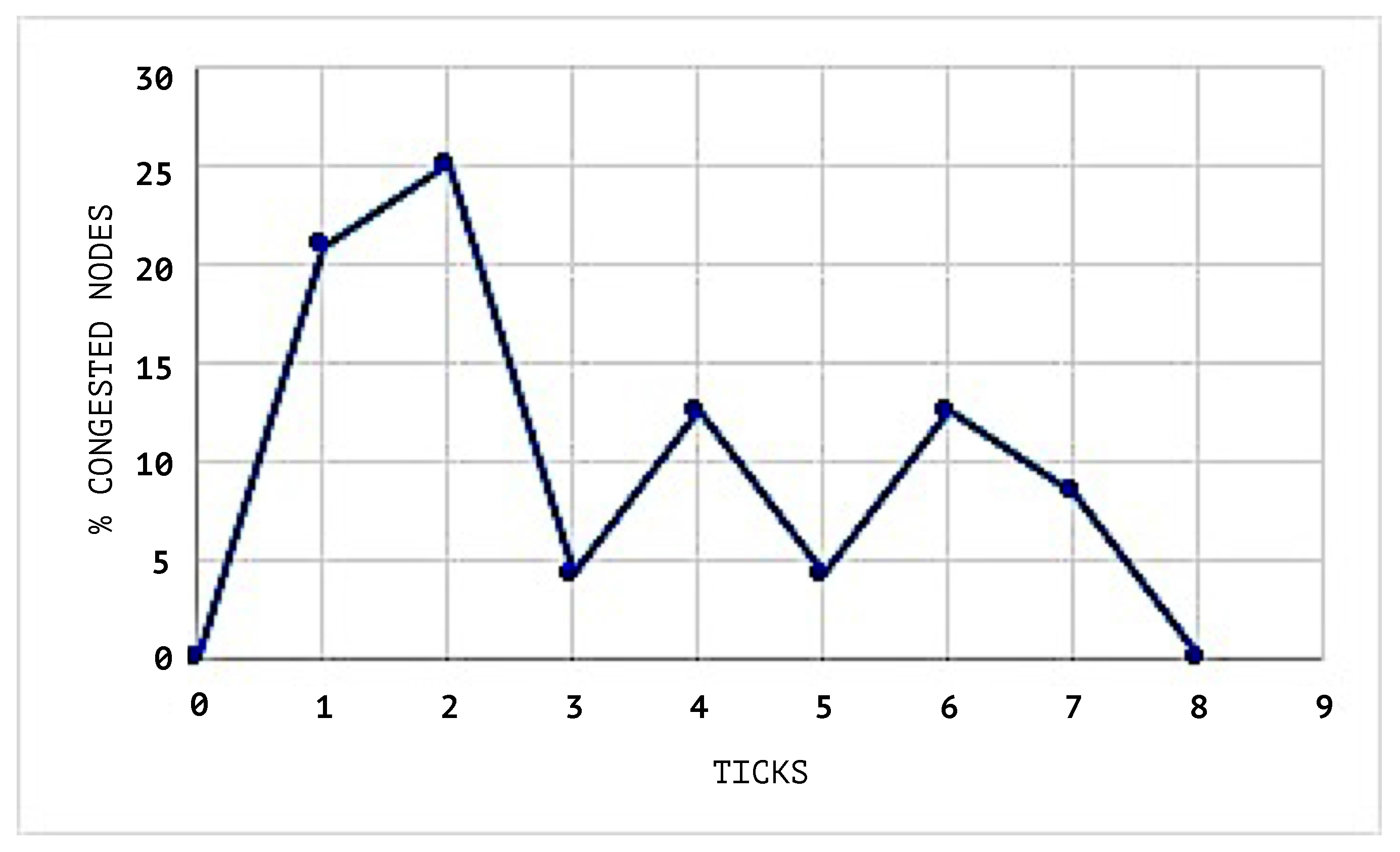
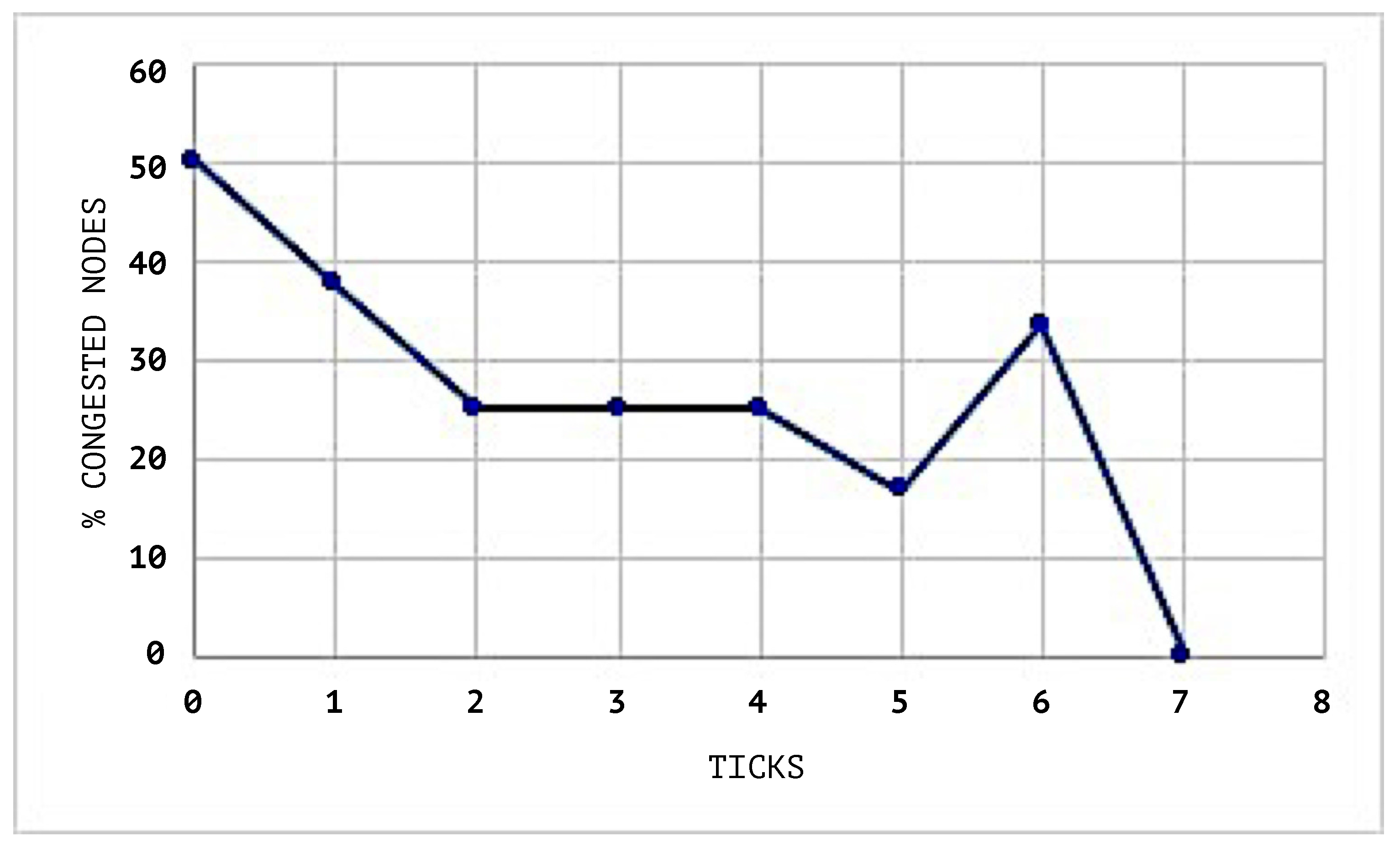
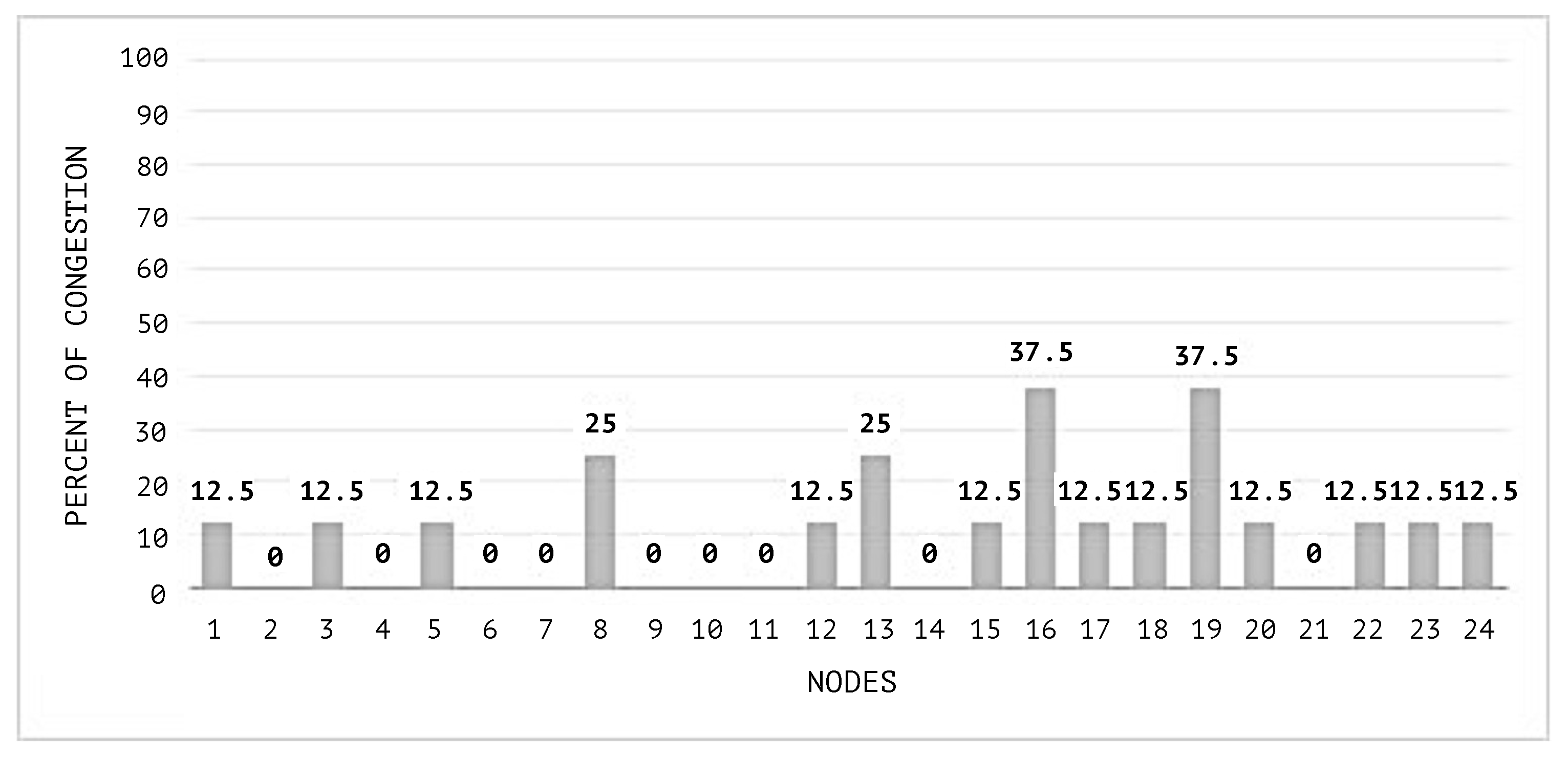
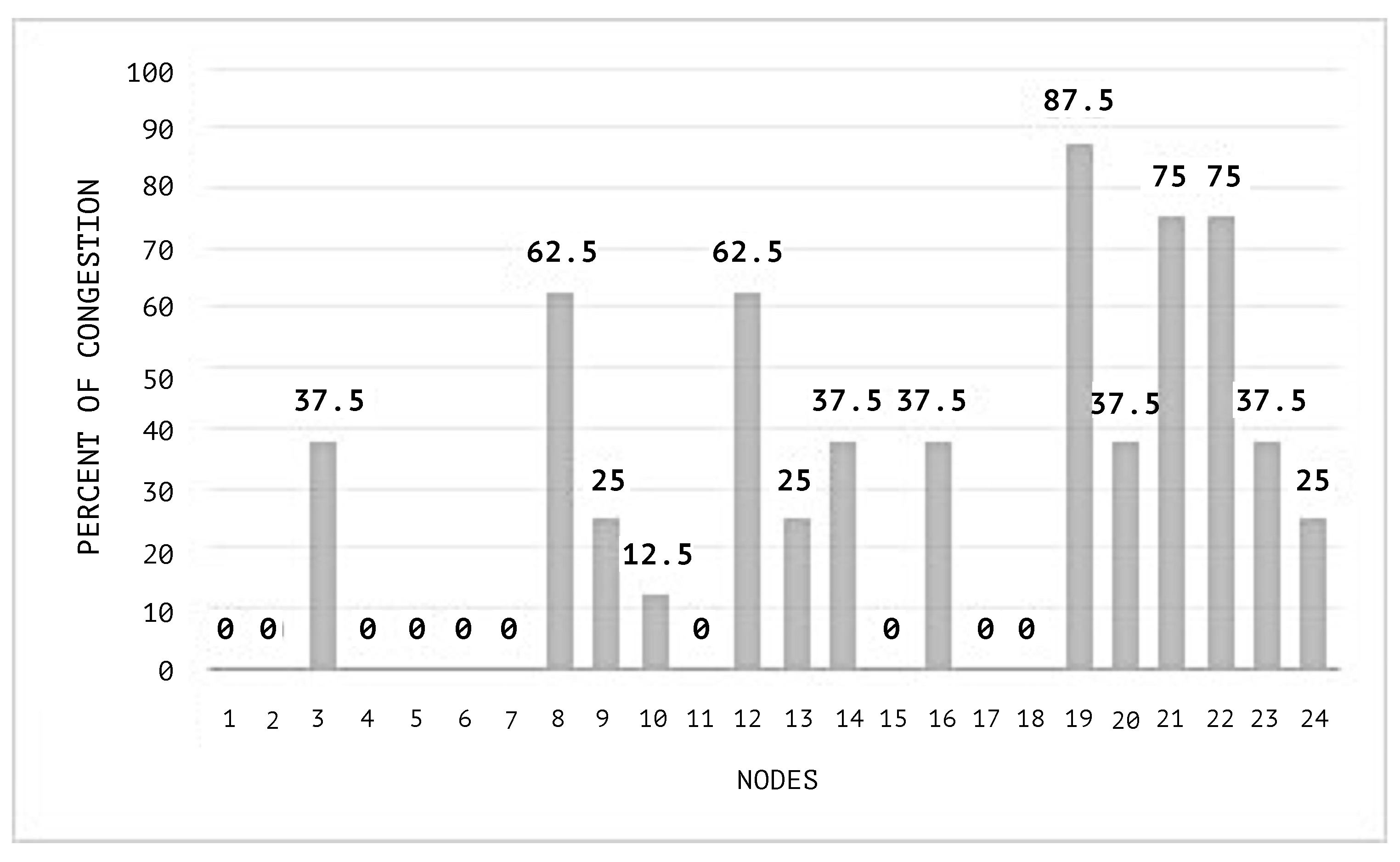

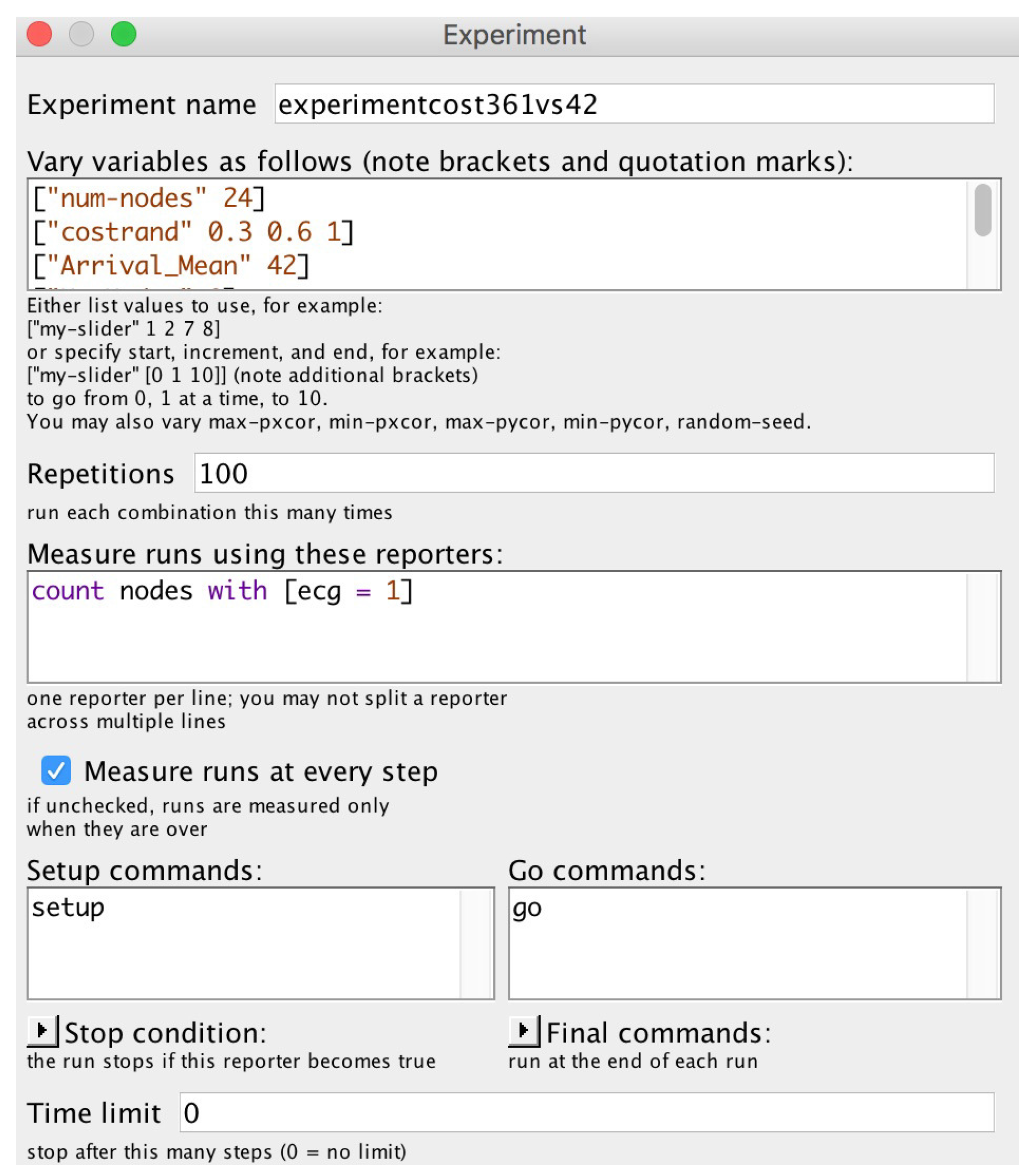
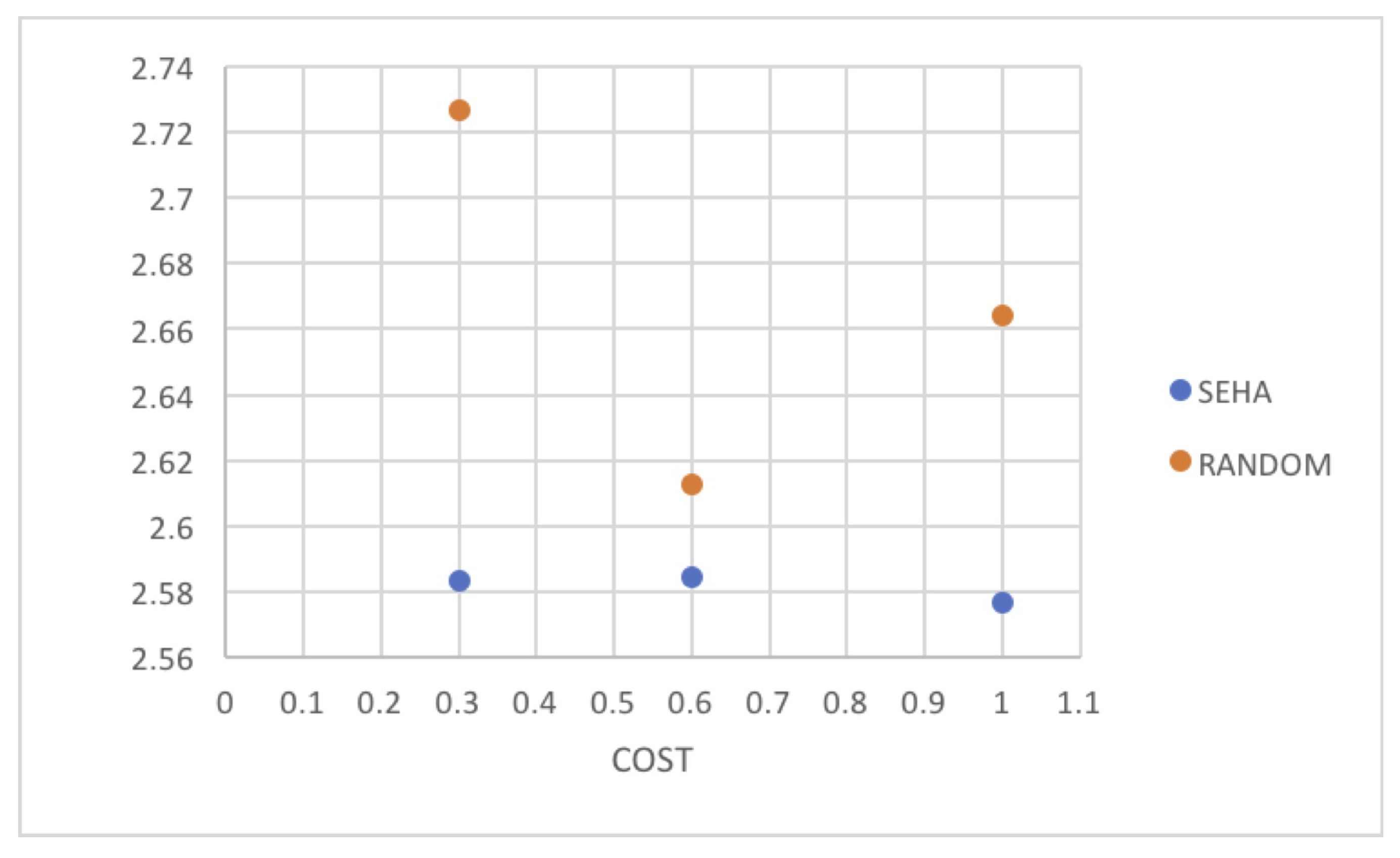
| Node | h | Preferences | Node | h | Preferences | ||||
|---|---|---|---|---|---|---|---|---|---|
| 0 | 0.34 | Voice | Video | Data | 12 | 0.15 | Data | Voice | Video |
| 1 | 1.00 | Voice | Video | Data | 13 | 0.079 | Video | Data | Voice |
| 2 | 0.604 | Data | Voice | Video | 14 | 0.069 | Voice | Data | Video |
| 3 | 0.533 | Data | Video | Voice | 15 | 0.272 | Video | Data | Voice |
| 4 | 0.181 | Data | Voice | Video | 16 | 0.34 | Data | Video | Voice |
| 5 | 0.232 | Data | Voice | Video | 17 | 0.104 | Data | Video | Voice |
| 6 | 0.34 | Data | Voice | Video | 18 | 0.34 | Video | Voice | Data |
| 7 | 0.442 | Voice | Video | Data | 19 | 0.092 | Voice | Data | Video |
| 8 | 0.272 | Video | Voice | Data | 20 | 0.104 | Video | Data | Voice |
| 9 | 0.204 | Data | Video | Voice | 21 | 0.035 | Video | Data | Voice |
| 10 | 0.15 | Voice | Data | Video | 22 | 0.035 | Voice | Video | Data |
| 11 | 0.181 | Voice | Data | Video | 23 | 0.092 | Data | Video | Voice |
| Number of Runs | Flows Mean Arrival Rate | Cost | Social Election with Hidden Authorities Algorithm | Random Distribution | ||
| Mean of Congested Nodes | Standard Deviation | Mean of Congested Nodes | Standard Deviation | |||
| 100 | 42 | 0.3 | 2.583 | 0.447 | 2.726 | 0.550 |
| 100 | 42 | 0.6 | 2.584 | 0.402 | 2.612 | 0.531 |
| 100 | 42 | 1.0 | 2.576 | 0.446 | 2.664 | 0.554 |
© 2017 by the authors. Licensee MDPI, Basel, Switzerland. This article is an open access article distributed under the terms and conditions of the Creative Commons Attribution (CC BY) license (http://creativecommons.org/licenses/by/4.0/).
Share and Cite
Raya-Díaz, K.; Gaxiola-Pacheco, C.; Castañón-Puga, M.; Palafox, L.E.; Castro, J.R.; Flores, D.-L. Agent-Based Model for Automaticity Management of Traffic Flows across the Network. Appl. Sci. 2017, 7, 928. https://doi.org/10.3390/app7090928
Raya-Díaz K, Gaxiola-Pacheco C, Castañón-Puga M, Palafox LE, Castro JR, Flores D-L. Agent-Based Model for Automaticity Management of Traffic Flows across the Network. Applied Sciences. 2017; 7(9):928. https://doi.org/10.3390/app7090928
Chicago/Turabian StyleRaya-Díaz, Karina, Carelia Gaxiola-Pacheco, Manuel Castañón-Puga, Luis E. Palafox, Juan R. Castro, and Dora-Luz Flores. 2017. "Agent-Based Model for Automaticity Management of Traffic Flows across the Network" Applied Sciences 7, no. 9: 928. https://doi.org/10.3390/app7090928
APA StyleRaya-Díaz, K., Gaxiola-Pacheco, C., Castañón-Puga, M., Palafox, L. E., Castro, J. R., & Flores, D.-L. (2017). Agent-Based Model for Automaticity Management of Traffic Flows across the Network. Applied Sciences, 7(9), 928. https://doi.org/10.3390/app7090928






